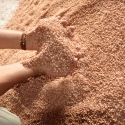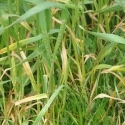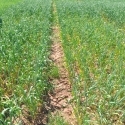23 Jul 2015
K experiment at Lake Bolac
Windrows indicate marginal K status
 Lake Bolac K experiment
Lake Bolac K experiment
October 2015 Update
Good responses to added K are still evident in both wheat and barley, although the response seems stronger in wheat. There appears little effect of lime, and the K responses on the old windrow areas are less than the responses between the windrows.
Some additional pictures can be seen in the gallery below.
In 2014, a wheat crop near Lake Bolac in Western Victoria showed windrow effects from the prior canola crop. Crop growth was better in the windrows than between the windrows (see link at left). K deficiency was diagnosed by tissue tests.
This site has been used for an experiment in 2015 to follow up this response, which could also be due to raised pH under the burned windrow. The 2015 experiment has liming treatments across the windrows and topdressed K at 4 rates will be applied with and without lime and on and between the windrows. Wheat and barley will be sown as the test crops, giving 32 treatments in total, with 4 replications. The layout of the site is shown in the diagram below:
The crop was inspected in early July and the windrow responses were showing up quite clearly and in a small demonstration next to the experiment, better growth was seen where K supply was enhanced.
Soil exchangeable K test values in the windrows are: 57 (0-10), 30 (10-20), 27 (20-30)
Soil exchangeable K test values between the windrows are: 43 (0-10), 27 (10-20), 23 (20-30).
This work is supported by the Grains Research and Devleopment Corporation, New South Wales Department of Primary Industries, Canpotex P/L (through Agrow P/L) and the International Plant Nutrition Institute. The experiment was sown by Southern Farming Systems and monitoring has been done through Ed Hilsdon from Landmark at Lake Bolac. Dr Jonathon Holland is the research scientist in charge of this project.
















